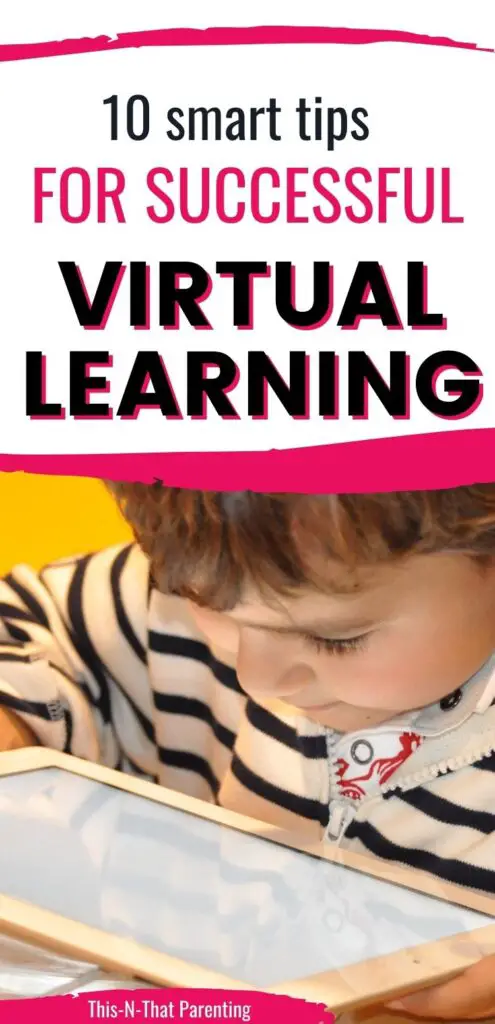10 Brilliant Tips To Help Your Child Thrive During Virtual Learning
Virtual learning seems to be all the rave these days. When I am at my child’s extracurriculars, I often hear parents asking each other, “Is your child doing virtual learning or face-to-face?”
If a parent answers, “Virtual learning,” the parents immediately begin sharing stories of the drama virtual learning has brought to their home.
As an elementary school teacher and a parent, I want to help parents navigate their child’s virtual learning experience and make it as positive as possible.
Now that we’ve had some time to reflect on virtual learning, parents, students, and educators are figuring out what works and what doesn’t work to create a virtual learning experience that provides the most success for students.
After interviewing virtual learning teachers and listening to students who have had successful virtual learning experiences, I have put together 10 tips for making the virtual learning experience the best it can be.
The tips that I provide you with cover supporting your child through their virtual experience physically, socially, and emotionally as well as academically of course. With no further introduction, let’s get right to set your family up for SUCCESS!
10 Tips For Making the Virtual Learning Experience the Best It Can Be
1. Create an optimum learning environment per your child’s learning style and personality.
In order to get buy-in from your child, your child needs to have some ownership or say in creating the space in which they do their virtual learning. Children want to feel in control, as do most all humans. When we give them some control in creating the space in which they spend a great deal of time, they are more cooperative.
Encourage your child to add decorations, artwork, or anything else that will motivate them and inspire them to want to be in the space.
The more the child feels seen in the space, the more pride they will take in using this area to do their virtual learning. This will be a win-win for everyone in the long run.
Here is a list of things to take into consideration when choosing and creating your child’s virtual learning area:
- Choose a space that is free from distractions. It is best if the area is away from all other screens. It takes a lot of self-control to ignore the TV or video games. Don’t even feed the temptation.
Use an area that is away from the major traffic hub of the home. You can even have them try a few different areas until ya’ll find the best fit. Whether a child sets up shop in their bedroom or in your closet, as long as success is the end result, location does not have to be fancy. - Make sure the lighting is good. The preferred lighting for the best learning is natural lighting. If you can’t make that happen, then read my article on choosing the most beneficial lighting for your family.
- Have all the supplies they will need. Your child will need at minimum pencils, a manual pencil sharpener, a clock and paper. Once your child knows what supplies they need, keep the space stocked, so your child is not having to run around the home looking for them when the teacher suggests their use.
4. Set high expectations for the organization and tidiness of the space. Research says that the orderliness or lack thereof of our physical environment is a representation of what our mental environment is or will become. Set your child up for success by teaching them to keep all of their supplies in their place.
5. Use noise reducing headphones in order to stay focused.

Headphones can increase concentration. Buying a pair of thick cushioned headphones can drown out distractions and help your child to focus on their learning.
Students who use headphones are more focused on lessons and are less distracted by noise from their surroundings than students who do not use headphones for virtual learning.
2. Be proactive. The child should be ready to troubleshoot during their virtual learning.
- Log in 5-10 minutes early in case there are connection issues.
- Keep water and snacks in an easy access area, so your child stays hydrated and able to focus.
- Have a plan. What will your child do if they need to use the restroom during a learning time?
- Make sure your child has had enough sleep. Get dressed, eat breakfast, and brush your teeth the same as if you were going to school.
- Your child has a plan to present or discuss a topic to their online community.
- Keep the extra paper near.
- Keep a plethora of sharpened pencils handy. A large eraser is a good idea too.
- Pets and younger siblings can’t jump into the lap of the learner.
- Mom is not breastfeeding or naked in the background. Breastfeeding and women’s bodies are a beautiful thing. Just not in the classroom. I know these are trying times, but together we have to draw the line. Ask me why I bring this up!!
- Brainstorm your own list of things that may go wrong during virtual learning. Have your child say how they would solve that issue.
3. Let Your Child Be Independent.
The most common thing I hear virtual teachers complaining about is that parents are helping students with their work too much. When a child who is performing at a C face-to-face suddenly begins making straight A’s virtually, it doesn’t take a teacher long to realize parents are doing the work or helping too much.
I’m not sure how to say this enough, but a parent is in no way, shape, or form benefitting their child by doing their work for them. In fact, a child would benefit more learning from their own mistakes than to watch their parent do their work.
Dear Parent of a Virtual Learner,
Now more than ever, it is very important to allow your child to do their own work. I hear you whispering in the background. I hear you grunting and moaning or coughing when he presses the wrong key. I still see your elbow on the side of the screen, even though you think you’re out of view after I ask you to leave.
I know you care tremendously about your child’s education. I know you just want to help. These are his tasks and his responsibilities. This is his time. You had your chance to do 2nd grade already.
I’m here to tell you that the best way you can help is to set your child up for success by following the steps in this article. Love him unconditionally and then leave him be. Absolutely do not do his job for him.
You would benefit to think of yourself as the facilitator or coach. You can practice with your child. You can strategize together on how to improve performance. You can help to organize assignments and give feedback. You can buy him supplies, wake him up in the morning, and prepare the healthiest of healthy breakfast.
Remember that when you take over a job for your child, you send the message that he is incapable. If he receives that message repeatedly, he will become incapable. Children become who you say they are, whether or not you send the message verbally or no!
Wishing your family all the best,
Your Child’s Virtual Teacher
I think you get the picture. Allow your child to be independent. You’ll be glad you did.
4. Hold your child accountable.
Be sure that your child knows the expectations of the parents and the teachers. Come up with a list of must-dos and non-negotiables. Hang the list in the learning area to refer to when needed.
If siblings are sharing devices and learning areas for virtual learning, make sure everyone understands who gets to use what and when.
Your child needs to know that playing Minecraft or scrolling through their phone while they have a Zoom meeting playing in the background is called technoference, and it’s not OK.
If your child has issues focusing, you may need to stay closer to keep them on track. Create nonverbal cues, so you can give them signals to get back to learning.
Talk with your child about the self-regulation it’s going to take to be successful with virtual learning. Help them develop an awareness of how they behave when they are unfocused. Discuss triggers that get your child off-task. The more a child is aware of thinking about their own behaviors, the more they will hold themselves accountable.
Research shows that students work harder when they take part in setting their learning goals and know that they will be held accountable for their learning.
Start the day with a brief discussion of what today’s learning goals are. Debrief at the end of the learning session on whether are not the learning goals were met and what the next steps are. Always celebrate met learning goals. It can be as small as a pat on the back or a high-five.
5. Help your child to reflect on their virtual learning experience.
While on one hand you are encouraging independence in your child on the otherhand you are the adult in the home. One way to facilitate independence is to teach your child to be in constant reflection about their virtual experience.
Once you have your child reflecting, you can show her how to move towards making tweaks to improve and move from more of an experience to an adventure.
The following are some ways to coach your child to reflect on their virtual learning experience and help them maximize their learning.
- Ask your child questions such as, “What was your favorite thing you learned today?”
- Sit and watch your child do a virtual lesson. Take a mental note of how your child is performing, interacting, and how you think things are going. Keep your opinion to yourself. Give it an hour or so after the lesson and then ask your child how they thought the lesson went. Ask them how they feel about virtual learning.
- Let your child know you are there for moral support.
- Ask your child how they feel about speaking on their virtual learning platform. If they are timid, make a plan, sit with them during their next meetup as an accountability partner.
- Ask your child, “On a scale of 1-10, 10 being awesome, how was today’s virtual learning experience for you?”
- Ask your child, “What can I do to better support you in your virtual learning experience?”
- Sit with your child at times when they are doing online work. Show them that you are interested. Have them explain things to you. Don’t take over or try to teach. Say things like, “I noticed you gave good effort on…”
- Ask your child, “Is there anything that you are struggling with on virtual learning that you could use some assistance with?” Don’t jump in and fix everything.
Note: If your child does not always give you a lengthy answer, don’t fret. You are nurturing your child’s ability to self-reflect and problem solve.
6. Create a daily virtual learning schedule.
Of course, your schedule will need to align with the virtual learning teacher’s schedule, but this is very possible. Build the virtual learning schedule into your home schedule.
Increasing predictability increases chances of success with children. Children thrive on routine. Being consistent about a routine can be very challenging for parents, but the benefits are worth it.
Related Article: How To Create A Daily Routine That Works For Your Family
What to build into your virtual learner’s daily schedule:
- A morning routine that includes getting dressed, brushing teeth, eating breakfast, and tasks that need to be completed before class begins
- Brain breaks. Here are 50 ideas for simple brain breaks. Other ways for students to take breaks are by doing puzzles or free reading.
- Healthy snack and water breaks. You can help your child to be more independent with snacks by setting up a snack station or by having your child prepare their own snacks ahead of time.
- Include a time for your child to get moving. Alertness, attention, ability to recall and understand and motivation are just a few of the benefits of exercise breaks.
- Build at least 20 minutes of parent-child time into the schedule. Maintaining a connection with your child is key to your relationship and getting their cooperation.
- Put unstructured time in the schedule, so your child has some choice and freedom to do as they wish at some point in their day.
- Be sure to have lunch and dinner on the schedule.
- If your child is in extracurriculars, you may have practice time on the schedule. i.e practice piano, practice kicking a ball into a goal, practice dance
- Chores
- Reading time
- Bedtime
It’s important to set expectations for how your virtual learner will transition between the times on their schedule. This doesn’t come naturally to humans. You can plan to teach the schedule.
The younger the child, the more you will have to scaffold the schedule for them and support them before releasing them into total independence. Shadow your child a couple of days moving through the schedule. Make this as stress-free an experience as possible. You are setting the tone. Make adjustments as necessary.
Note, the more time you spend building the foundation for your virtual learning experience, the better off you’ll be in the long run. In education, we say that we’re slowing down to speed up.
Revisit your systems, schedules, routines, goals, and rules often, and don’t hesitate to make changes where needed. This is an awesome experience for students to take part in. The more you involve them in problem-solving and the more heard they feel in finding solutions, the more cooperation you’ll get.
7. Set and maintain boundaries.
Boundaries expert, Nedra Glover Tawwab, suggests that parents should be sure to keep healthy boundaries in place during their time at home with their children. Tawwab tells parents they should try to keep things as close to pre-pandemic life as possible.
If you are home with your child while they are engaged in their virtual learning, it is necessary for all those who are present to have boundaries and to be aware of each other’s boundaries. More importantly, everyone needs to respect the boundaries that have been set.
Examples of some boundaries that Nedra Tawwab gave on a podcast I was listening to are:
- Just because I am home does not mean I am available.
- From 6 to 7, you can not come to ask me anything.
- Still put on your school clothes.
- This is not a vacation. We still have to do life.
- Keep the same structure you had pre-pandemic. If kids didn’t eat in the bedroom before, they don’t need to now.
- When I am on a Zoom call, I am off-limits, and I need the place to be silent.
Each family member can write a list of boundaries they need their family to respect. At a family meeting, have family members present the boundaries. Support younger children in coming up with the language they need to create boundaries. Each family member can post their boundaries, so ya’ll can review them when needed.
8. Communicate with your child’s teacher.
Effective communication between parent, teacher, and student is the leading indicator in the success of a child’s school success.
If you have questions or concerns, it is best to contact your child’s teacher to make sure everyone is on the same page. You don’t want to become high-maintenance for your child’s teacher. At the same time, teachers appreciate a parent who wants to see their child succeed. Teachers want your child to succeed as well, and they will work with you.
Two popular articles for how to communicate with your child’s teacher are:
- How To Have An Effective Parent-Teacher Conference
- How To Send An Effective Email To Your Child’s Teacher
In these articles, you will find a guidebook to parent-teacher conferences and sample emails to teachers. If you have any anxiety about getting the communication right with your child’s educator, you will get your answers in these 2 articles.
Again, teacher’s, teachers, and students must work together to ensure the child has the best school year possible. Don’t hesitate to communicate with your child’s virtual learning teacher.
When you do communicate with your child’s teacher, remember that your child is not the teacher’s only student. Be patient in receiving feedback from the teacher. In the meantime, wait and do ya’lls best.
9. Connect and network with other virtual learners.
One thing I hear from teachers over and over is that they see that their virtual learners are in need of social interaction with others who are like them. They say it is evident that the students need to be seen and heard.
Students are trying to get attention. Teachers do not always have the time to listen to personal story after story or meet each student’s pet. This is why it is important that parents help their virtual learners form relationships outside of class.
When students connect with each other, they can support each other, share what is and isn’t working for each family, and just interact and have an everyday conversation.
If your child’s class does not have a discussion group, you can be proactive and get the group started or talk to your child’s teacher about getting a group started. Virtual meetups are a great way for online learners to feel connected to the outside world during a pandemic. It is so important for everyone to know they are not alone in their experience.
10. Set a positive example and keep a growth mindset.
First and foremost, your children are listening and watching. They are taking in your opinion and your reactions to virtual learning. This is why it is imperative for parents to keep a positive attitude about virtual learning just as it is for face-to-face learning. Children look to their parents to see how to act in new or overwhelming situations. This can be fortunate or unfortunate. It’s up to you.
From the beginning, families need to be prepared to give themselves and each other grace. You are treading in new territory with virtual learning. The more the leader models a team or a “We’re all in this together” atmosphere, the more the virtual learner will develop that attitude.
A parent’s attitude is contagious. The more excitement and energy you bring to online learning, the more excited your child will be about the experience.
After studying thousands of children, Dr. Carol Dweck coined the terms fixed mindset and growth mindset. With a fixed mindset, students do not believe they can improve intelligence or artistic ability. When students have a growth mindset, they believe they can get smarter. Then, they put in extra time and effort that leads to higher achievement.
In order to help your child maintain a growth mindset about their virtual experience, it is important to consider the language that you use when giving your child feedback.
Here are some examples of communication that support a growth mindset:
- This is hard, and we can do hard things.
- We’re not sure how to go in a chat room YET, but we will figure it out.
- Everything is figureoutable. We will get this soon.
- We weren’t born knowing how to walk but look at us now.
- We will learn from our mistakes.
- Let’s take this enormous task and break it into smaller chunks that seem more manageable.
- When your child says, “I don’t get this.” or “This is too hard.” You can respond, “You don’t understand this YET, but with effort, you will get it.”
- If you’re not making mistakes, you’re not learning. It’s ok to make mistakes. You will get this figured out.
- It’s OK there are going to be tech issues from time to time. Let’s practice staying calm when things don’t turn out like we wish.
- Someday we will look back at this experience with pride that we made it through.
Wrap It Up Virtual Learning Tips
Families are taking on more responsibility for their children’s education than ever before. In order to have a successful distance learning experience, families need a plan.
I believe the tips that are provided in the post will help you and your child navigate virtual learning. In fact, I believe you will have a stellar experience. Remember, your brain believes whatever you tell it, so say you believe this too.
Whatever you believe, you will achieve. Now go out and achieve an exceptional virtual learning experience with your family. You’re making memories!
Comment: I’d love to hear about your virtual experience. Share any ideas that were not covered in this post.
Education Resources For You
- 10 Ways Intentional Parents Raise Confident Kids
- How To Send An Effective Email To Your Child’s Teacher: The Dos and Don’ts
- Lighting: How It Affects Your Child Physically, Mentally, and Academically
- 7 Shocking Facts About The Development Of Your Child’s Prefrontal Cortex
- Advocating for Your Child At School – Stay Involved!
- 10 Brilliant Tips To Help Your Child Thrive During Virtual Learning
- A List Of Parenting Resources: The Best Of The Best
- Peaceful Parent Happy Kids by Dr. Laura Markham: A Book Review
- Time To Parent by Julie Morgenstern: A Book Review
- 200 FREE Kid-Friendly Alexa Commands For Your Echo Device

Make it a great day or not, the choice is yours! Remember to have fun, laugh and give God the glory! I love you! SS








